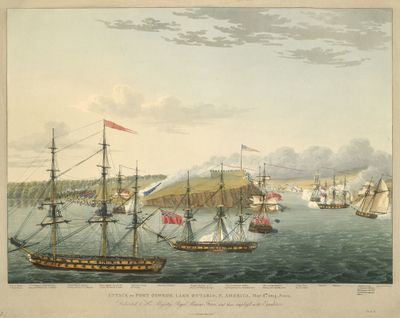Attack on Fort Oswego, Lake Ontario, N. America
Description
- Featured Link
- Creators
- Hewitt, John, Artist
- Havell, Robert, Engraver
- Item Type
- Aquatints
- Description
- A view of the Battle of Fort Oswego, fought on 6 May 1814 between the British, commanded by Commodore Sir James Lucas Yeo, R.N. (1782-1818) and the Americans, commanded by George Edward Mitchell (1781-1832), resulting in a British victory. The War of 1812 (1812-15).
Yeo had been appointed commodore and commander-in-chief of the warships on the North American lakes on 19 March 1813. He had built two large ships during 1813-14 and these, together with the rest of his squadron (seen in the foreground of this view), were used to carry a large number of troops to attack Fort Oswego in early May 1814.
Fort Oswego, seen in the centre of this view, flying the American flag (which is not drawn with any pretence at accuracy as to the number of stars and stripes) was not the strong structure it had been during the French and Indian War of 1754-63. Although, in 1814, was an important staging post on the American supply route from New York, its defences had crumbled, and its guns were damaged. Nevertheless, the Americans put up a strong resistance and can be seen here, in a line on the slope below the fort, firing at the British troops which had just landed. - Inscriptions
- ATTACK on FORT OSWEGO, LAKE ONTARIO, N. AMERICA. May 6.th 1814, Noon.
Dedicated to His Majesty's Royal Marine Forces, and those employ'd on the Expedition.
London. Published May 1, 1815
Drawn by J. Hewitt, Lt Royal Marines
1 Cy of Glengary Light Infantry
2 Flank co's DeWatterville, Col Fischer
2d Battn Royal Marines
forming Column Lt Col Malcolm
Prince Regent, Sir Jas Yeo,
Lt Genl Drummond & Staff
Charwell, covering the landing
American Troops, &c.
Princess Charlotte, 4 Co's Reserve of DeWatterville's Regt
Fort, 300 American Artillery,
1 Capt, 2 Lieut, 30 Seamen, & British Deserters
Star, covering Seamen & marines under Capt. Mulcaster
Oswego Town
American Vessels
Montreal
Niagara
Magnet firing at American Militia With Engineers, Art. R. M. with Rockets, Sappers & Miners
Engrav'd by R. Havell
Plate 1 - Date of Original
- 1815
- Date Of Event
- 6 May 1814
- Image Dimensions
-
Image Width: 54.8cm
Image Height: 43.9cm
- Subject(s)
- Local identifier
- RCIN 735185.4.a
- Collection
- Royal Collection Trust
- Language of Item
- English
- Geographic Coverage
-
-
New York, United States
Latitude: 43.4659 Longitude: -76.50828 -
New York, United States
Latitude: 43.4944651351087 Longitude: -76.5283527832031
-
- Copyright Statement
- Copyright status unknown. Responsibility for determining the copyright status and any use rests exclusively with the user.
- Contact

 View image on the Royal Collection Trust site
View image on the Royal Collection Trust site
